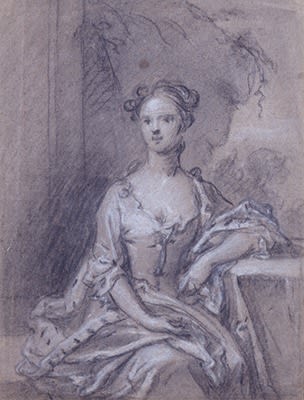
Sir Godfrey Kneller Bt.
Study for a portrait of a Lady, c. 1690
Black chalk on paper
11 3/4 x 9 in. (22.5 x 27.5 cm)
Philip Mould & Co.
To view all current artworks for sale visit philipmould.com Unlike their successors, British painters of the late seventeenth and early eighteenth century have left few drawings behind them. Although drawing...
To view all current artworks for sale visit philipmould.com
Unlike their successors, British painters of the late seventeenth and early eighteenth century have left few drawings behind them. Although drawing must have been as essential element of their craft -and, no doubt, a recreation- of major painters only Jonathan Richardson and Sir Godfrey Kneller are credited with a sizeable and recognisable oeuvre.
Kneller's drawings are invariably associated with portrait commissions. Finished presentation drawings exist, but they are rare. They range from almost schematic treatments of the figure -such as the drawing for his portrait of Admiral Benbow (Historical Portraits) - in which the artist is clearly resolving compositional questions at a very preliminary stage of a project, to more finished modelli such as the present drawing. Here, the degree of shading and the inclusion of background and accessories suggest that this drawing represents a stage very close to the execution of the portrait in oil.
Kneller's use of drawings has been a matter of debate, which goes to the heart of his practice in portraiture. There is a number of surviving head studies, of greater or lesser finish, which so closely duplicate the completed oil portraits - King George I (Windsor Castle), William Congreve (Witt Collection) - that it is clear that Kneller used drawings to fix the sitter's likeness for the final painting. The famous instance of the portrait of Lady Mary Wortley Montagu cited in Pope's Letters has often been drawn to suggest that this single drawing occasioned Kneller's only contact with his client, and that the entire painting was based upon one sitting alone. From other sources, however, it is known that Kneller frequently required numerous sittings from his clients, and more finished drawings such as this present example may have been an important part of the consultation between him and the patron.
Unlike their successors, British painters of the late seventeenth and early eighteenth century have left few drawings behind them. Although drawing must have been as essential element of their craft -and, no doubt, a recreation- of major painters only Jonathan Richardson and Sir Godfrey Kneller are credited with a sizeable and recognisable oeuvre.
Kneller's drawings are invariably associated with portrait commissions. Finished presentation drawings exist, but they are rare. They range from almost schematic treatments of the figure -such as the drawing for his portrait of Admiral Benbow (Historical Portraits) - in which the artist is clearly resolving compositional questions at a very preliminary stage of a project, to more finished modelli such as the present drawing. Here, the degree of shading and the inclusion of background and accessories suggest that this drawing represents a stage very close to the execution of the portrait in oil.
Kneller's use of drawings has been a matter of debate, which goes to the heart of his practice in portraiture. There is a number of surviving head studies, of greater or lesser finish, which so closely duplicate the completed oil portraits - King George I (Windsor Castle), William Congreve (Witt Collection) - that it is clear that Kneller used drawings to fix the sitter's likeness for the final painting. The famous instance of the portrait of Lady Mary Wortley Montagu cited in Pope's Letters has often been drawn to suggest that this single drawing occasioned Kneller's only contact with his client, and that the entire painting was based upon one sitting alone. From other sources, however, it is known that Kneller frequently required numerous sittings from his clients, and more finished drawings such as this present example may have been an important part of the consultation between him and the patron.
Be the first to hear about our available artworks
* denotes required fields
We will process the personal data you have supplied in accordance with our privacy policy (available on request). You can unsubscribe or change your preferences at any time by clicking the link in our emails.